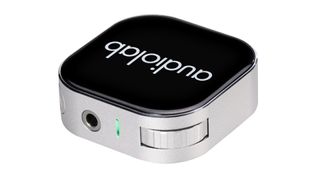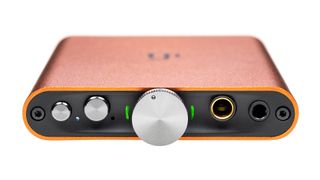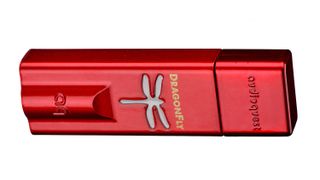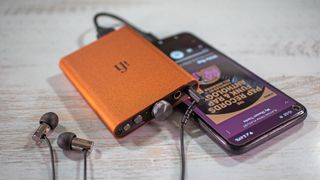If you’ve never heard of a “DAC”, don’t worry, most people haven’t. The thing is, it is one of the best ways to improve the quality of the digital music we consume every day, whether that be through a phone, laptop or proper audio system. (Only listen to music exclusively through vinyl? This probably isn’t the article for you.)
We have a whole explainer on what a DAC is and does here, but essentially it’s a device – available in all shapes and sizes and at all kinds of prices – that converts a digital audio signal (a Spotify stream or local music file playing on your phone, say) to an analogue audio signal so that it can be output (i.e listened to) through speakers or (if it has a headphone socket output, which most do) a pair of headphones. This explains its full name – Digital to Analogue Converter.
It’s likely you’ll own at least one device with a DAC inside – any digital kit you have with a 3.5mm headphone port, such as a laptop or tablet, for starters – but the converters built into these everyday devices, and even digital hi-fi components, aren’t typically of high quality and therefore music doesn’t sound all that great after it’s been passed through (and converted by) them. Getting a decent, dedicated external DAC can remedy that and help you enjoy your music more. It could make more of a difference to your music enjoyment than any other purchase. Here’s why now’s a particularly good time to invest in one…
- Here are the best DACs for the business
They work across multiple devices
Now that USB-C is becoming more and more ubiquitous in the consumer electronics market (even the iPhone is heading that way soon), more and more DACs have USB-C inputs, making them more universal across multiple types of devices than ever before. That means you can use one DAC for your Android phone, laptop and iPad if you like.
Even USB stick-like (USB-A) DACs – and older ones with USB-B inputs, for that matter – can easily be made compatible with USB-C devices these days thanks to the increasingly common, discreet and cheap adapters that can attach to the end of it, enabling the DAC to plug into your device. USB-A DACs are just as easy to make compatible with iPhones, too, via Apple’s Lightning-to-USB camera adaptor.
Whether they’re primarily designed to or not, many DACs designed first and foremost for portable/desktop use can also slot into hi-fi systems without too much faff as well.
They're becoming less reliant on wires

Most DACs with built-in headphones amplifiers, portable or otherwise, need to be wired to a device and headphones (device > cable > DAC > cable > headphones)… but not all. The iFi Go Blu and Audiolab M-DAC nano (pictured above) are two examples of portable DACs that can take one wire out of the equation at least – the one between it and your source device. Yes, you still need wired headphones* to take advantage, but both of these five-star examples show that your portable sound can still be significantly boosted without compromising much on convenience. With desktop/hi-fi DACs, Bluetooth is becoming a box that is ticked more often than not, too.
*While dedicated wired headphones are ideal partners for DACs with headphone amps, you can always use a pair of wireless headphones wired (that’s what the supplied cable is for, after all!) with a DAC for circumstances where you crave better sound quality than a Bluetooth headphone connection can offer.
They make for easy hi-fi system upgrades
We’re speaking generally here, but sources and amplifiers that offer digital connectivity – especially those at the more affordable end of the market – don’t often have particularly high-quality DAC stages built in, using run-of-the-mill off-the-shelf DAC chips and only benefitting from limited budget spent maximising its output stage. If you’re buying a £1000/$1000/AU$2000 stereo amp with digital connections, for example, the DAC inside is likely to be the same quality as an external, dedicated one five times cheaper. If you regularly play digital sources – a CD player or laptop, say – through your hi-fi system, plugging them into an external DAC that is itself connected to your amplifier’s analogue input could be the easiest way to upgrade your system. As well as offering a sonic upgrade, an external DAC could add extra features to your system, too, such as Bluetooth or wider digital file support.
Likewise, if you’re happy with your all-analogue amplifier for most of your listening but would like the added flexibility to play music from a digital source on occasion, adding an external DAC to it could be a better option than replacing it with a digital-friendly amp.
They reveal the quality of audio you’re playing

If you stream music in hi-res quality from a hi-res streaming service, you might have realised that it’s not always easy to see what bit rate ('24-bit) or sampling rate ('96kHz') – i.e the quality – a track actually is. Sampling rates of songs vary from album to album, but not all streaming service interfaces show what it actually is. Some DACs, such as the iFi hip-dac 2 (pictured above), Chord Mojo 2 and Cambridge Audio DacMagic 200M, however, can tell you the sampling rate of a file it is playing through their (often colour-coded) LED light displays, which can offer some reassurance that you are getting the quality you think you are.
They increasingly support Tidal Masters
If you look down our best DAC buying guide, half of the top 10 recommended products support MQA (Master Quality Authenticated), the technology that powers Tidal’s hi-res ‘Masters’ streams. Tidal is no longer the only or most affordable hi-res service worth considering, but in our minds it is still the best, and the increasing number of devices supporting its hi-res streams only helps further its case.
The fact that hi-res audio is becoming more of a ‘thing’, primarily thanks to tech giants Apple and Amazon supporting it on their music services, also makes the role DACs play more relevant than ever. After all, why spend money on the better-sounding music that is now very accessible if you don’t have kit that sounds good enough to truly take advantage of it?
They improve low-quality files too

You don’t need to play hi-res audio to benefit from using a DAC, though. While every DAC we’ve come across supports hi-res audio, they will make an audible difference to even your Spotify streams – again, so long as you have semi-decent headphones (i.e not EarPods!) that are transparent enough to hear what the DAC is doing. As we said in our AudioQuest DragonFly Red DAC review and is also the case for others of its calibre, "If you want to take things back to basics and are wondering whether a DAC such as this will make a difference to your daily dose of Spotify, allow us to confirm that it will. Even these comparatively low-res streams get a hefty improvement in the detail, definition and dynamic departments."
That said, you will hear more discernible differences and get optimum results feeding it lossless CD-quality content and above.
They can be very affordable
Like most things, DACs vary in quality and therefore price. But as a fairly recent crop designed for our phones, laptops and other portable devices to improve on-the-go sound have appeared, they have been sensibly priced as such. Our favourite budget desktop DAC ideal for a laptop or computer is the iFi Zen DAC V2, priced £135 / $189 / AU$265, while the aforementioned AudioQuest DragonFly Red and iFi Go Blu are both under £180 / $230 / AU$300 too. For a modest outlay, they will do wonders for your everyday music enjoyment.
You won't be surprised to read that you can spend slightly or significantly more to get better sound quality in the desktop/portable market, though, while the same rules apply to hi-fi DACs as they do other hi-fi components: get one at a level appropriate for the rest of your system.
MORE:
What is a DAC? And do you need one?
Wireless headphones are the best they’ve ever been – and yet the wire is more relevant than before
MP3, AAC, WAV, FLAC: all the audio file formats explained

